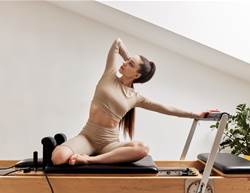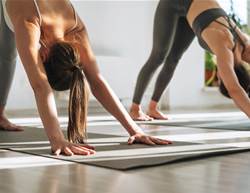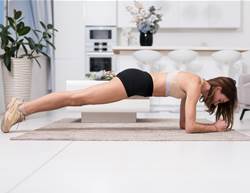Rebounding workouts use a mini-trampoline to build balance, mobility, strength and cardio. Experts say it’s low-impact on the joints, helps circulation and, best of all, brings back the playful joy of moving.
“The elastic surface of a trampoline creates the gentle bounce that makes it so joint-friendly,” says physical therapist Tara Phaff. You don’t need a trampoline (often called a rebounder) to try the concept, though. You can mimic it with gentle, rhythmic movements that load and unload the joints on a mat, the floor or even a vibration plate, Phaff adds.
Because many rebounding moves are balance-focused, consider safety, your current ability and any needed modifications before you start. Below, trainers and physiotherapists outline options and simple exercises to try.
Rebound exercise benefits
Rebounding comes with plenty of upsides. The gentle up-and-down motion acts like a pump for your lymphatic system, helping move cellular waste, explains Phaff. The circulation boost may support immune health, lift energy and more. Because the rebounder absorbs impact, it’s kinder to your knees, hips and spine while still loading joints enough to help maintain bone density, Phaff adds.
Balance and coordination also get a workout. “It’s especially effective for improving proprioception, which is your body’s awareness of movement and space,” says Phaff. Rebounding challenges postural muscles, ankle stabilisers and the core, which is particularly useful for older adults.
You’ll tick the cardio box too. The bounce elevates heart rate and helps you “naturally recruit deep stabilisers, including the transverse abdominis and pelvic floor, to stay balanced,” Phaff explains. There’s a mental lift as well — shaking it out on a mini-trampoline can help release stress and spark endorphins.
You don’t need a mini-trampoline to see benefits. A wide exercise mat can work for low-impact, rhythmic loading and unloading. If you do use a rebounder, choose one with a balance bar and use it for stability, especially when you’re starting out.
Rebounding workout for beginners
Start slow, especially if it’s your first time on a rebounder. Engage your core for stability and practise any of the moves below for up to two minutes. As your tolerance improves, gradually build to 5–20 minutes, says physiotherapist Alex Germano.
Rebounding exercises with a trampoline
Before a bounce-a-thon, check that the surface, springs and legs are secure and sturdy, as this equipment is prone to wear and tear. Grip socks can add extra traction.
It’s very important to use a rebounder meant for exercise and not a toy trampoline. Start slow and increase speed only when it feels comfortable. Try these basics:
Health bounce
Keep feet flat on the trampoline, hip-width apart. Gently press through the heels in a rhythmic motion to encourage lymphatic flow and light core and calf engagement. Stay relaxed with a soft bend in the knees.
Basic bounce
Begin with the health bounce, then add a small lift-off. Bounce lightly with control to build lower-body endurance. Land softly through the balls of your feet and maintain tall posture.
March in place
Lift one foot at a time in a gentle marching motion to add cardio and work the hip flexors and legs. Keep movements light to avoid heavy impact.
Side step
Step or bounce side to side, shifting weight evenly between your legs to work hips, glutes and ankle stability. Keep hips level and movements smooth, says Phaff.
Heel digs
Tap one heel forward into the mat or trampoline as you gently bounce to engage hamstrings, glutes and coordination. You can add alternating arm swings if your balance feels steady.
Jumping jacks
Step or lightly bounce legs out and in for cardiovascular endurance and hip mobility. This also works the core, calves and hip muscles, notes Germano.
Twist
Rotate hips side to side while turning your upper body the opposite way, as if wringing out your torso like a wet towel.
Wide bounce
Stand upright with feet shoulder-width or wider. Hold a small mini squat and bounce to target core, calves, lymphatic flow and glutes.
Back foot taps
With feet hip-width apart, start a small bounce and alternate tapping one foot behind you. Add a chest press—push hands forward with palms facing away—while stepping back for an extra challenge, says Germano.
Forward kick
Begin with a light two-foot bounce, then alternate kicking one leg forward. Add a double bounce on each side if you want more challenge. This dance-like move builds single-leg stability and hip-flexor strength, says Germano.
Rebounding exercises without a trampoline
You can do these moves on the floor. “Mimic the same movement patterns by trying gentle bouncing, marching or shifting weight side to side on the floor,” says strength coach Matt Dustin. Keep knees soft, brace your core and work near a wall or bench if you want extra support.
- Health bounce
- Basic bounce
- Back foot taps
- Jumping jacks
- Forward kick
“It’s best to focus on rhythm and control rather than height.” In other words, avoid big jumps and hard landings so the session stays low impact and joint friendly.
Rebounding mistakes, risks, and safety tips
“Rebounding is generally safe when performed with proper technique and equipment, but there are a few precautions to consider—especially for beginners, older adults or those with health conditions,” says Phaff. Keep these in mind:
-
Balance and stability: Falling off a rebounder or losing balance is the most common risk, says Phaff. Use a support bar, start with small controlled movements and wear non-slip or grip socks.
-
Ankle and knee strain: “Overly aggressive bouncing or locking the knees can lead to joint strain. Always keep a soft bend and maintain control,” Phaff says.
-
Dizziness or motion sensitivity: If you’re prone to motion sickness, you may feel light-headed or nauseous. Phaff recommends one to two-minute bouts at first, building up gradually as tolerated.
-
Pelvic floor or core weakness: People with prolapse (when one or more pelvic organs drop), incontinence or postnatal changes may need modifications. “Seated or gentle heel-bounce options can be used safely under professional guidance,” says Phaff.
-
Health conditions: Those with advanced joint degeneration or osteoporosis, uncontrolled high blood pressure, severe neck or back pain, recent surgery or retinal conditions sensitive to pressure changes should see a GP before trying rebounding, Phaff concludes.
If any of the above applies, work with a qualified exercise professional such as a physiotherapist or occupational therapist. Set up your space for success, adds Germano: place the rebounder on a flat, non-slip surface with clear room around it. “Have the rebounder in an area where you can get off and sit quickly in case of any discomfort or fatigue,” she says.










